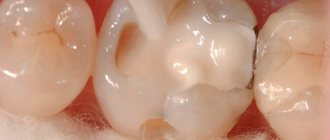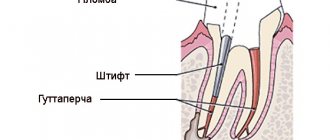Many patients do not know that they can put fillings on their front teeth. Its goal is not only to eliminate defects, but also to restore anatomical, physiological and aesthetic properties.
The procedure is quite popular. In order for the result to please the patient, it is necessary to choose a competent specialist with extensive experience. A professional will select the necessary material individually for each type of teeth and install the product so that it will not be noticeable in the smile area.
Installing a temporary filling
A filling between the front teeth is often placed due to carious lesions. For several days, it protects healthy tissues and nerve endings from external influences.
After a session of cleaning the canals and removing the nerve, the structure is replaced with a permanent one.
Life time
temporary product depends on the need for installation. As a rule, it is worn for no more than one month. Lasts about three days if arsenic is present.
When treating pulpitis or advanced stages of caries, the reaction of the unit is checked. Antibiotics are applied under the material. In this case, you need to walk for at least three weeks. The installation method is identical.
The following can be used as the main material:
- polycarboxylate cement,
- dentine,
- vinoxol,
- karyosan,
- softened paste
Who is contraindicated for anesthesia?
There are three main contraindications to the use of local anesthetics during dental treatment in the clinic:
- Pathologies of the cardiovascular system (stroke and heart attack, after which less than six months have passed).
- Endocrine diseases in the stage of decompensation - thyrotoxicosis, diabetes mellitus. It is recommended that patients of the first and second groups treat caries and other dental diseases only in a hospital.
- Allergic reactions to anesthesia and anesthetic components. In this case, it is recommended to conduct allergy tests and find out which drugs you are allergic to. If it is selective, caries can be treated with an anesthetic injection - but only one to which you are not allergic. If the tests show a reaction to all anesthetics, you will have to treat your teeth without pain relief or look for alternative options. Sometimes the solution for allergy sufferers may be sedation, which puts a person into a state of half-asleep and partially disables reactions. In this state, the pain is felt much less.
Replacing a filling
Sometimes it becomes necessary to change fillings on the front teeth. Replacement is due if it is fixed:
- Violation of the integrity of the closure of the carious cavity. This process provokes infection.
- Vertical or horizontal shrinkage of material.
- Heavy load due to chewing. Because of this, destruction occurs.
- The development of periodontal tissue diseases - gingivitis, periodontitis.
- Overhang of the edges on the gum.
- Wear due to flat occlusal surface.
- Change in the shade of an artificial tooth (usually darkening).
- Poor quality of oral hygiene.
- Diastema of the frontal units.
- Changing the inclination.
- Insufficient cleaning of dental plaque in the area adjacent to adjacent molars.
Filling materials
They can be very different. The most important thing when filling is to close the holes that have formed in the tooth. It is also necessary to restore the functions of the tooth. Therefore, when choosing a material, the location of the tooth and the possible load are taken into account.
If the chewing tooth is severely damaged, then polymers can be used; they can withstand heavy loads. As for the anterior teeth, light-curing composites are more often used here. With their help, you can create a shade that is most reminiscent of natural. For incisors and their filling, silicate and silicophosphate cements are usually used.
Materials must meet certain requirements. They should not dissolve in dental tissues, be easy to remove if repeated treatment is needed, not enter into a chemical reaction with the tooth, and ensure complete sealing of the tooth canals.
Painfulness of the procedure
Most people are afraid of the procedure precisely because of toothache, but modern technology and the use of anesthesia eliminate this ailment.
The session is completely painless. To reduce the likelihood of discomfort, all manipulations are carried out after the administration of an anesthetic. If there is no nerve, the procedure is performed without anesthesia. The patient may feel slight pressure on the gum.
An exception is intolerance to certain medications used for anesthesia. The choice is made in favor of a similar drug with a different active substance.
After the injection, no painful sensations are observed.
It hurts if there is a strong inflammatory process at the root apex and in the canals. Unpleasant sensations occur only when the drug gets into the periodontal tissues. They go away instantly after increasing the dosage of the painkiller.
Some pain is possible if there is a deep stage of carious lesions, depulpation or canal treatment is performed, or sensitivity is increased.
What anesthesia is used in the treatment of caries?
To remove tooth sensitivity and treat it painlessly, the dentist selects the appropriate type of anesthesia for each patient.
The most common are three types - application, infiltration and conduction:
- Application involves pain relief without injections. A gel or solution of an anesthetic is applied to the oral mucosa, which reduces the sensitivity of the tissues in this area. Most often, topical anesthesia is performed when treating or removing baby teeth. It is also used to numb the injection site.
- Infiltration is anesthesia with an injection of an anesthetic, which is injected relatively shallowly and affects the peripheral nerves. This type of anesthesia is often performed in the treatment of caries and pulpitis. After the injection, the patient does not feel pain and feels comfortable in the dental chair.
- Conduction anesthesia acts on large nerve canals and trunks. With its help, you can remove the sensitivity of half the jaw. It can be used for caries, which is complicated by a serious inflammatory process, during surgery.
The type of anesthesia, as well as the drug used to numb the teeth, is selected by the dentist.
Installation on the front teeth
The procedure takes from half an hour to an hour and a half, depending on the complexity of the problem.
The stages of setting up the frontal units are as follows:
- Carrying out professional oral hygiene. The hygienist cleans the molars and interdental space from plaque.
- Determination of tone.
- Introduction of anesthesia. The anesthetic is selected taking into account the patient's tolerance to the active substance. The injection is given in the gum area.
- Removal of caries. If the pathology affects only the superficial layers, then the disease is eliminated by grinding.
- Removal of the inflamed area of the pulp.
- Preparing the plane. The dentist treats the surface with a drill.
- Acid and adhesive treatment of dentin and enamel for better adhesion.
- Treatment with an antiseptic solution. This point is important in order to reduce the risk of microbial development.
- Application of material. It hardens quickly, so it is important to “shrink” it immediately with a special tool.
- Bite check. To do this, the doctor asks the patient to bite down on a plate of dye. When a certain area of this element is painted, a violation is considered.
Performing grinding and polishing of the artificial surface for proper bite and ideal smoothness.
When restoring the anterior dentition, diastema closure is often performed. This is possible if the spaces between the central molars are small. More material is applied to the incisors to increase their width. Thus, the distance between them disappears.
Is it painful to have a filling?
Many readers remember very well from their own bitter experience how toothache was treated in Soviet times. Modern medicine has made giant leaps forward. So, knowing how teeth are filled now, we are no longer so afraid of going to the dentist. This is why the number of people suffering from toothache who are terrified of sitting in the doctor’s chair has been rapidly decreasing in recent years.
Nowadays, a patient in a good clinic is not even faced with the choice of treating a diseased tooth without or with anesthesia, and the choice of anesthetics is so wide that even an allergy sufferer will not have to suffer from pain. A couple of injections into the gums, and for quite a long time the patient does not experience any pain, and a slight sensitivity after filling, which usually goes away within a maximum of two days, can be relieved by modern painkillers or traditional medicine.
Types of fillings for front teeth
The design on the frontal incisors must have such properties as resistance to abrasion and destruction, biocompatibility, thermal conductivity to protect against exposure to different temperatures, and matching the enamel in structure and shade.
There are several types of materials. They have their own characteristics:
- Cement silicophosphate
(zinc phosphate or polycarboxylate) material. Among the advantages, it is worth highlighting the low cost. However, there are many more disadvantages: Firstly, fixation and adherence to the walls is insufficient. Secondly, the color is noticeably different, since the cement quickly acquires a yellowish tint. Thirdly, the surface of the artificially created unit is poorly polished. - Composite
The structure, shape and color of a natural incisor are most clearly conveyed. It is characterized by increased strength. The downside is the risk of roughness if the material is not mixed well. - Plastic.
Its advantages include a tight fit, aesthetic component and mechanical strength of the material. The color palette is wide and you can easily choose a shade to match the color of your teeth. The negative aspects are that the plastic darkens and turns yellow, the surface gradually becomes rough, acrylic releases toxins and also shrinks.
When choosing, you need to know how long different types of fillings last. Cement is short-lived. Their service life does not exceed one and a half years. Plastic products last up to three years. Good composite fillings last up to five years.
The best choice of fillings for front teeth
The filling must close the cavity and prevent infection of the canals. In the case of front teeth, the aesthetic aspect comes to the fore, so the material must have the appropriate properties.
The most durable fillings for damaged front teeth are light products
. They are made from a material that hardens under ultraviolet rays. The composition contains heliocomposite, glass-ceramic filler, and resin.
Durability of photopolymers
Photopolymers are characterized by increased strength. They can last up to 10 years. They are resistant to temperature, restore length and shape.
Reflective filling has many advantages
:
- Eating food and water is allowed immediately.
- Increased adhesive ability.
- Plastic. The material allows you to clean out any pores and cracks.
- Layer-by-layer application. Due to this, the grip is enhanced.
- The percentage of shrinkage is minimal compared to chemical analogues.
- Does not release toxins.
- Possibility of fixing in a small area.
- Possibility of choosing a color that is similar to enamel.
Minus
is high cost. As a result of the use of a UV lamp, the price does not allow the use of a light filling as a temporary structure.
Yellowing of fillings on front teeth
Patients often experience discoloration of artificial units.
Causes
Common causes of pathology are:
- Getting injured.
- Secondary caries.
- Drinking black tea or coffee.
- Smoking.
Darkening is possible when the nerve is removed.
Correction methods
The first step is to carry out the whitening procedure. You can get rid of yellowing only with photopolymers. Only if the structure has lightened slightly does it need to be replaced.
Whitening methods
Photopolymers are bleached using the in-channel method. A special gel is injected into the root canal and a temporary structure is placed. After 2-3 procedures, the shade becomes lighter, and the structure is replaced with a permanent one.
Lost filling on a front tooth
Causes
The reason for material loss may be:
- Neglect of oral hygiene and, as a result, plaque formation.
- Untimely removal of tartar.
- Inflammation of the pulp.
- Mechanical injuries.
- Chewing food with frontal incisors.
- Poor tooth preparation before the procedure.
- Eating seeds, nuts, etc.
- Excessive load on the front units. For example, opening lids, chewing threads, etc.
Elimination methods
With high-quality elimination of carious cavities, correction is carried out within a month. If the product was placed in the treatment of deep caries, then you should immediately contact the dentist to exclude an infectious process.
Treatment is prescribed depending on the cause of the loss. If there is repeated caries or loss of a pulpless tooth, re-installation does not make sense. The doctor suggests installing a pin or crown.
What to do if a piece of the filling breaks off
In this case, you should immediately visit a dentist
. The doctor will correct the problem in one visit if no spread of secondary caries is noticed.
If the chip occurs from the edge, then the restoration is carried out with the same material that was originally used. If a significant part has broken off, the doctor suggests changing the material or performing a complete restoration and extension.
The filling on the front teeth interferes after treatment
In some cases, the design on the frontal incisors prevents the mouth from closing completely; the roughness injures the tongue or the mucous membrane of the lips.
Causes
Trouble arises if sufficient grinding and grinding of the excess surface has not been carried out.
Much less commonly, the cause is an excess of applied material when correcting the interdental gap on the front teeth.
The rarest situation occurs when the wall between the filling and the pulp chamber is thinned. There is a feeling of discomfort that irritates the nerve.
Complications
Ignoring pathology can lead to unpleasant consequences. For example:
- The high position of the artificial structure causes a lot of pressure on the jaw. Pulpitis and periodontitis gradually develop.
- Increases the likelihood of chipping.
- Uneven closing of the jaw contributes to its dislocation and other diseases of the temporomandibular apparatus.
Possible complications
Dental treatment, like any other medical intervention, can lead to complications.
Typically patients face the following problems:
- Dental treatment, like any other medical intervention, can lead to complications
infection of the opened cavity, which leads to the spread of pathogenic microflora under the filling and its loss ahead of time;
- penetration of infection into the root area, which is fraught with granuloma, cyst with subsequent loss of the masticatory organ;
- malocclusion due to improper grinding in the clinic;
- penetration of toxic filling materials into the area of the dental nerve, followed by pulpitis or peridontitis if the dental filling technique is violated.
To avoid complications, you should contact a reputable clinic and take precautions after filling a molar.









